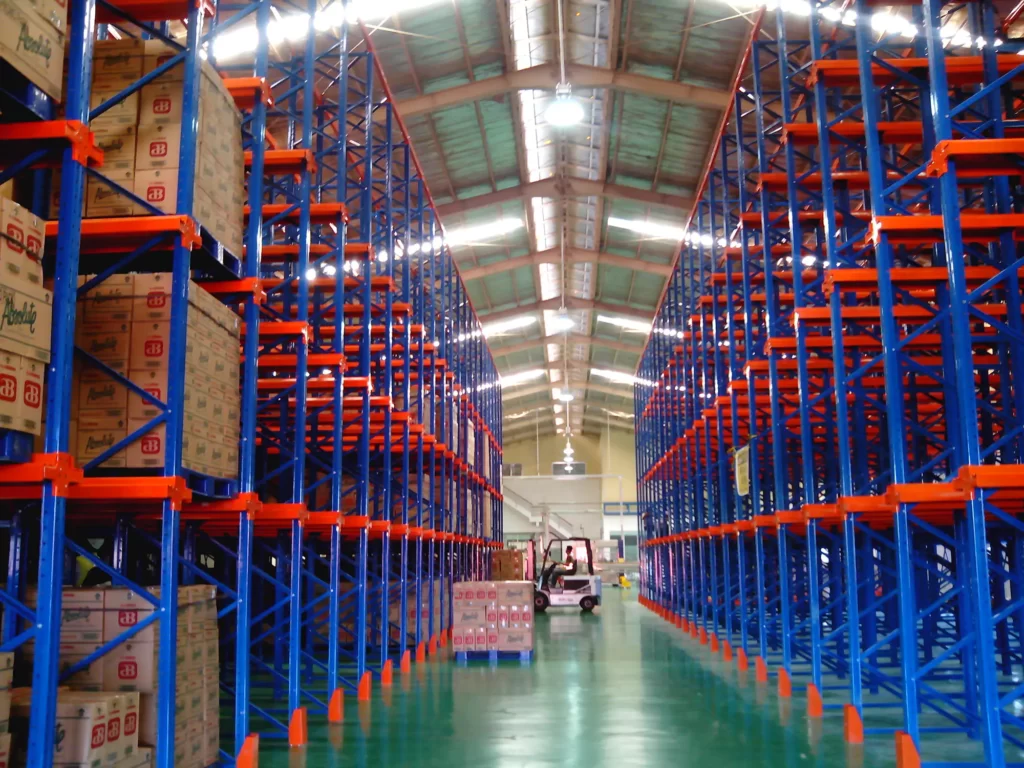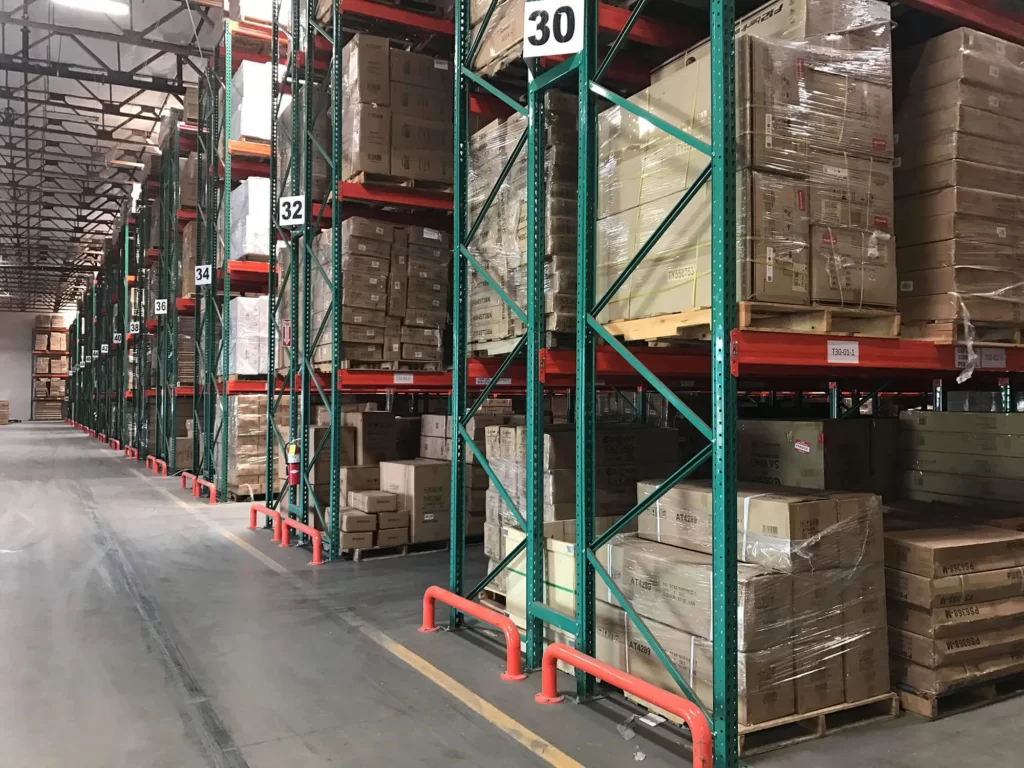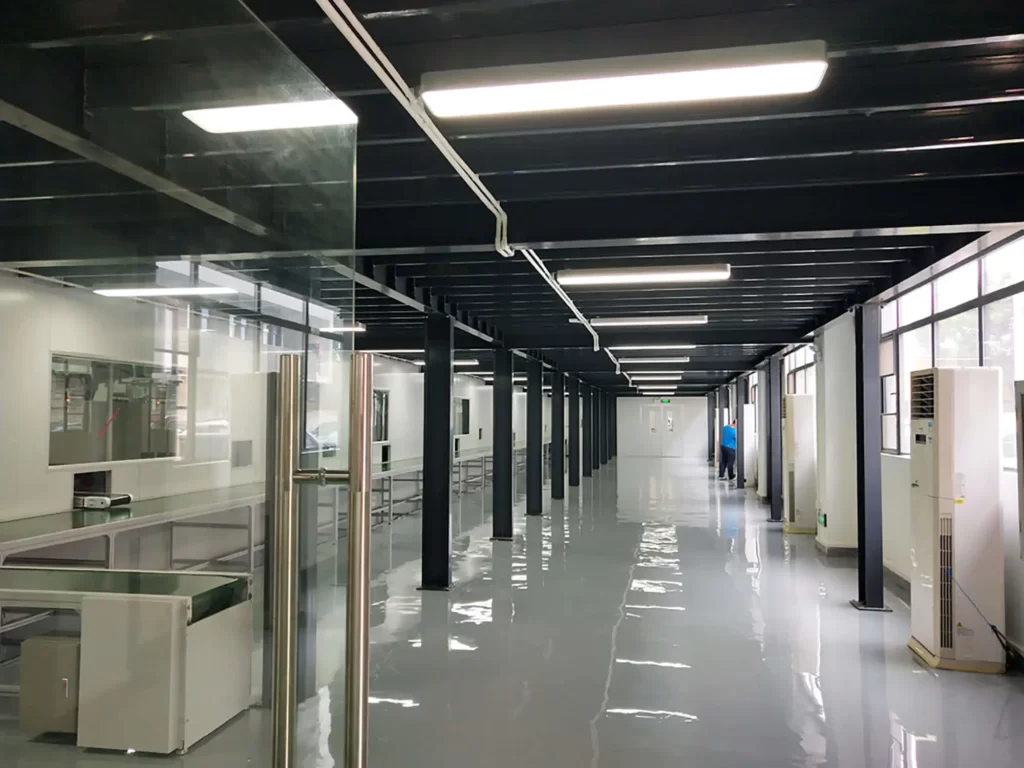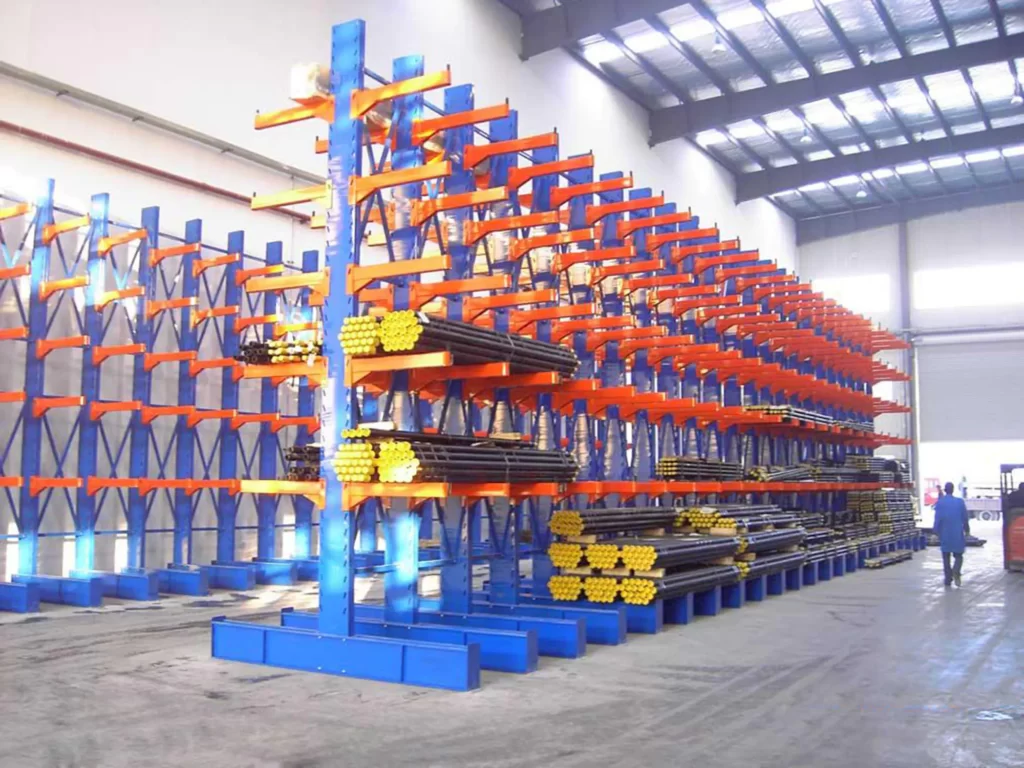Equipment that is used to move, store, distribution, consumables, etc. is known as material handling equipment (MHE). It helps us to store, move, load, and ship out our material. Today we will discuss the most complete list of warehouse material handling equipment.
The value of material handling equipment is significant. A well-thought-out material handling system will help to cut expenses. It will lessen the likelihood of mishaps and property damage.
Nowadays technology rapidly improves warehouse efficiency. The creation and application of automated solutions, such as robots for moving products, machines for extracting products, and automated picking systems have been made possible by new warehouse technology.
So, Technology has a great impact on warehouse efficiency. In this article, we will discuss both technological and traditional warehouse material handling equipment. We will also discuss the following things in this article:
Traditional Warehouse Material Handling Equipment List.
Material handling equipment that has been in use for a long time, and generally, no technology is used while operating this warehouse material handling equipment, is called traditional warehouse material handling equipment.
Some of the most famous traditional warehouse material handling equipment are as follows:
Forklifts

A forklift is one kind of vehicle which is also called an industrial truck, lift truck, etc. It is used to lift and move material over a short distance. Almost all forklifts evenly distribute the load’s weight between their prongs.
Additionally, the engine’s weight and large metal plates, known as the counterbalance, support the truck’s rear end. Consider a forklift as a seesaw, with the front wheels acting as the center of balance.
The chassis, the mast, and the overhead guard are the three major parts of forklifts. The standard size of forklifts is the width from about 3 feet to 7 feet and in length from about 8 feet to 10 feet.
The lifting capacity of a forklift is 1-1.8 tons,1.8-3.3 tons, or 3.3-6.5 tons. Forklifts have stop and accelerator pedals for controlling this mechanism.
Crane
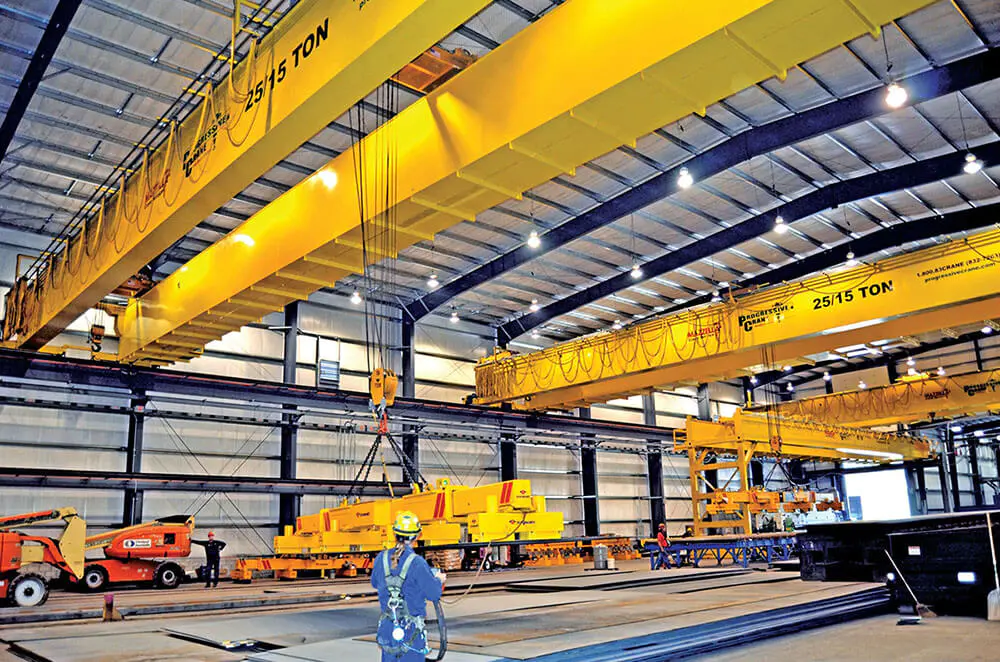
Cranes are machines used to lift and move heavy materials within a warehouse. There are two types of cranes.
One is a Static crane that raises and transfers goods along fixed paths and is a permanent structure attached to floors or buildings.
Another one is a mobile crane, which can be transported from one place to another and is positioned on treads or wheels.
Cranes are used to lift or lower objects and move them horizontally. Every crane comes with pulleys and cables that are helpful for moving goods around. The hook, hoist, trolley, and bridge are part of a crane.
Cranes abide by the law of conservation of energy. As a result, the energy supplied to the load cannot be more than the energy supplied to the machine. The typical crane has a lifting capacity of 1–6 tons.
Pallet jacks

Pallet jacks are machines that can be manual or electric. It is also known as a pallet pump, pallet truck, etc, It is used to raise and transport pallets. Pallet jacks, which are made of polyurethane, nylon, or rubber, rely on four wheels to convey products.
The forks, handle, and actuation lever are the three basic components of a pallet jack. The maximum lifting capability of common pallet jacks ranges from 3000 to 5,500 LBS. It is operated by one person. The usual height ranges from 3″ at the lowest point to 7 34″ at its highest point.
Conveyor systems
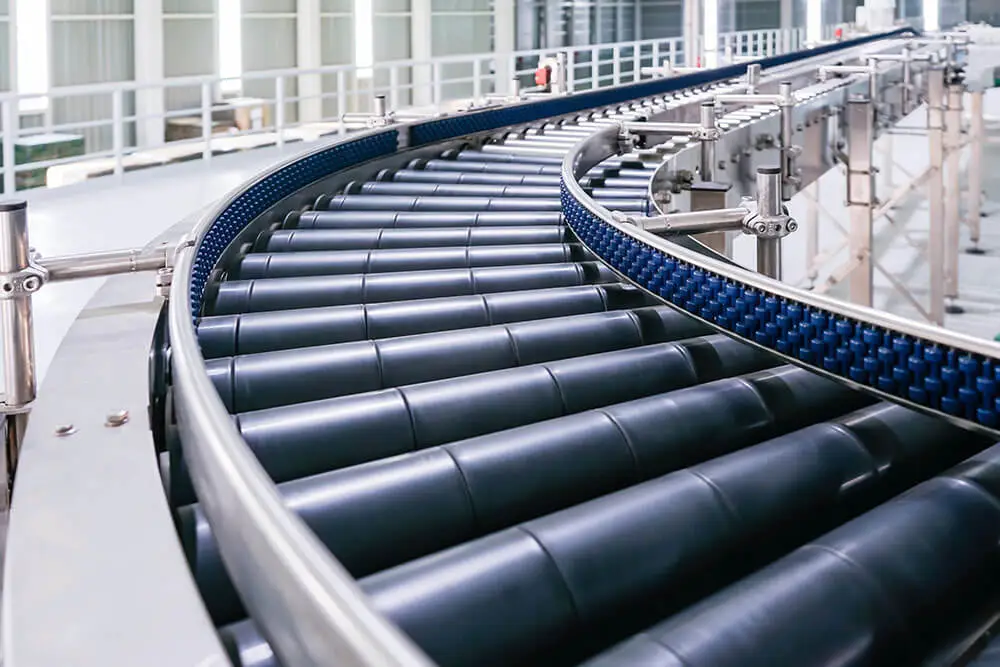
A mechanical handling device that moves loads and materials automatically throughout a space is called a conveyor system. It is a fast and efficient system. The main advantage of this system is to technology decreases human error, lowers workplace dangers, and lowers labor expenses.
Pneumatic, screw, belt, and roller are different types of conveying systems. This apparatus can either be operated manually, by gravity, or by a motor.
Conveyor belts are mostly comprised of five materials: thermoplastics, metal, rubber, fabric, and leather. There are some safety issues with conveyor systems which are as follows:
- Avoid stepping, sitting, and riding on the conveyors.
- Prior to the conveyor being locked out, do not attempt to remove any trash or trapped objects.
- Do not alter or remove guards or safety devices
The most used conveyor is a belt conveyor. There are two types of chain conveyors: one is a drag conveyor, and another one is a Multiflexing chain conveyor.
AC induction motor is used in conveyor systems. Conveyor systems are used for different sectors of applications in industries such as automotive, pharmaceutical, chemical, and so on.
Roll containers
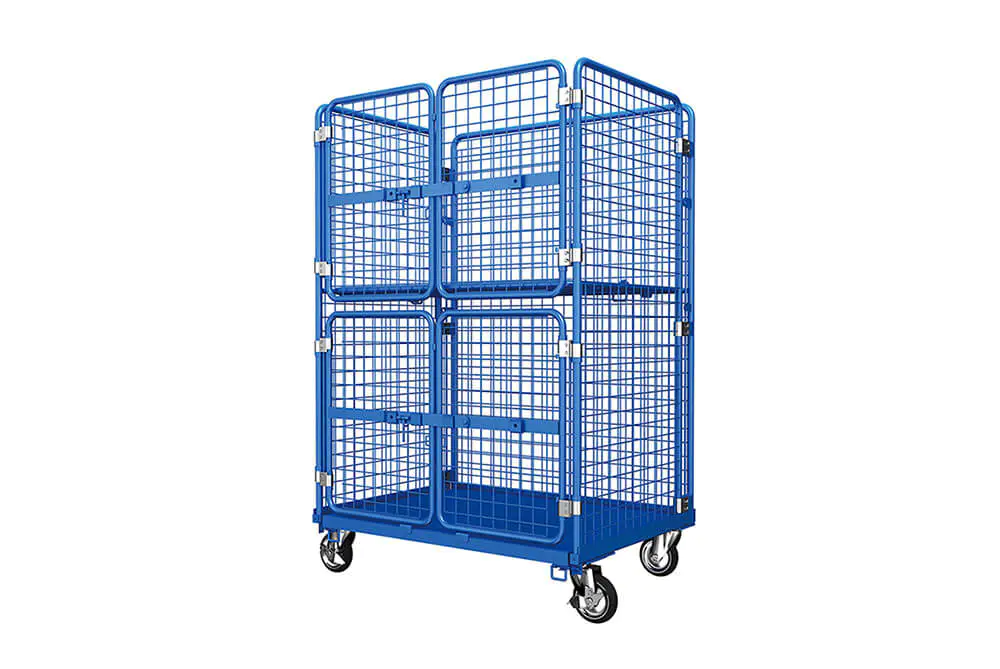
A roll container is one kind of cage that is used to hold and transport products in a warehouse. In any commercial or professional setting, roll containers are a great option for handling, shipping, and storage activities. There are different types of roll containers:
- Demountable Roll Containers
- Economy Four-Sided Roll containers
- Nestable Roll Containers
- Full Security Roll Containers
- Three-sided roll containers
Roll containers offer total protection for the items held within, which is a huge advantage. Roll containers are incredibly strong, resilient, and more than capable of managing challenging circumstances.
Roll cages are quite effective to utilize and provide 100% performance due to the fact that one cage may handle hundreds of KG at a time. Roll containers are a low-cost investment too.
Wire containers

A wire container is a container with a metal openwork design. Standard wire containers are sometimes referred to as storage cages and freight cages in a warehouse. It is constructed of high-strength steel wires, So, it can support heavy loads.
Other variations of wire containers include logistic carts, also known as logistic trolleys, which have stable and sturdy castors to keep them from obstructing the ground.
Folded wire containers and Wire containers with hollow sheets are also other variations of wire containers. Wire containers are in different sizes according to wirehouse demand.
Wire containers are used in the following places:
- Warehouse
- Factory
- Supermarket
- Automobile industry
- Hospital
The benefit of wire container is Easy Storage and Handling, No Rusting Issues, Outstanding Durability, and Less Chance Of Theft. Wire container is also cost-efficient.
Platform trolleys
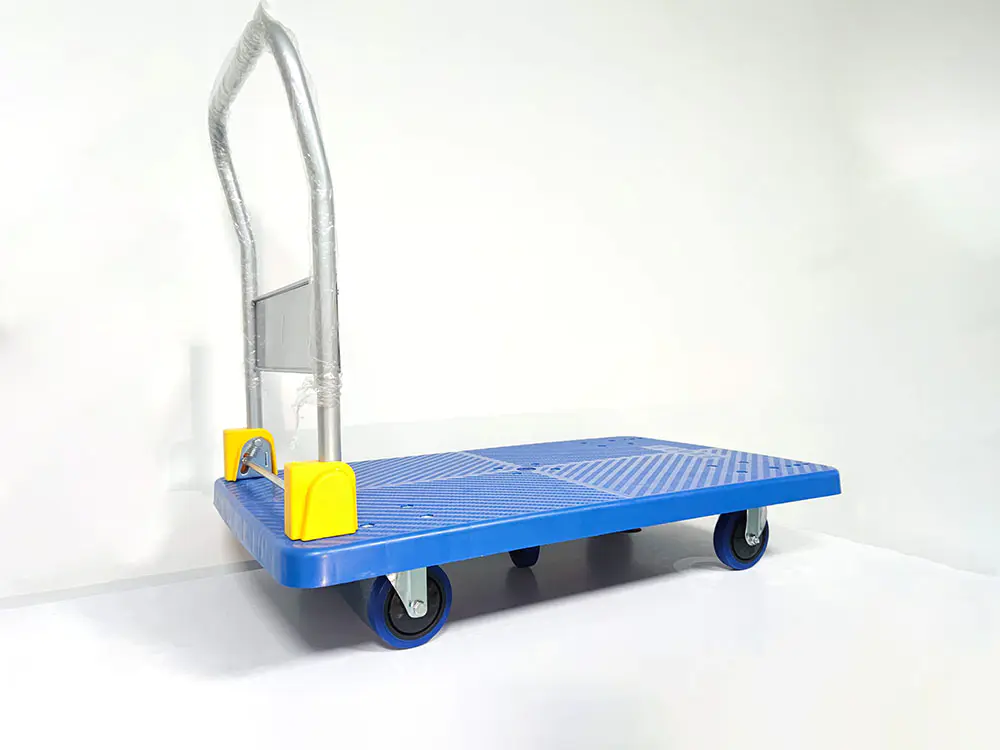
Wheeled carts known as platform trolleys are used to move items in warehouses and other commercial locations. This equipment is made to make it simple to transfer objects that are both heavy and large.
They typically consist of a flat platform or deck that is mounted on four wheels, with a handle at one end for pushing or pulling
Platform trolleys are used in the following places:
- Factories
- Warehouse
- Retail store
- Hospital
Depending on the use and load requirements, platform trolleys come in a variety of sizes, forms, and weight capabilities. Platform trolleys are made of different materials such as steel, aluminum, plastic, wood, etc.
Benefit of plastform trolleys is-
- Easy to use
- Cost-effective
- Increased productivity
- Improved safety
Some benefits of using a trolley for material handling are:
- Reduce fatigue and improve ergonomics
- Reduce the risk of accident
- Increased productivity
- Cost-effective
So, This item can be the perfect solution for you and your moving dilemma if you work in a field that needs the movement of big loads and objects. In total, platform trolleys are important tools for moving goods efficiently and safely in many different environments.
Hand Trucks
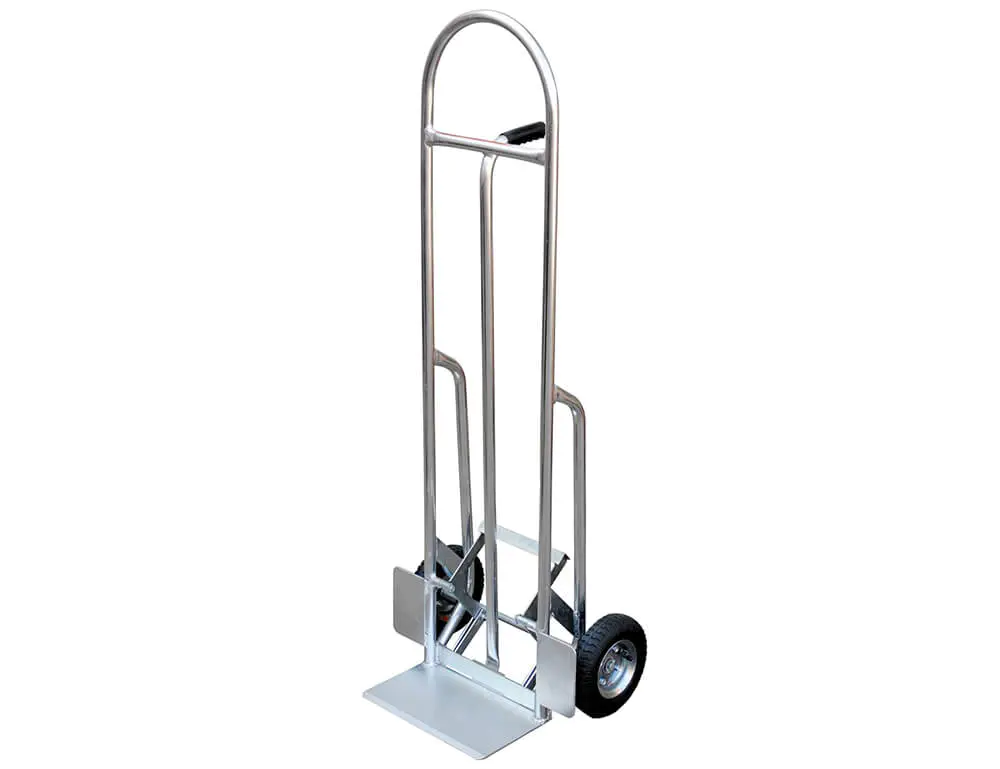
Workers can carry bulky or heavy objects with the least amount of physical effort by using hand trucks. They consist of a platform for transporting items, a handle, and a frame with two wheels.
Hand trucks are available in different sizes and weight capacities to suit different needs. They can be adjustable by attaching different accessories to suit the task at hand.
The usage of hand trucks gets a lot of tasks done that would otherwise require hard physical labor. Some of the advantages a warehouse can have using hand trucks are:
- Hand trucks reduce physical strain for warehouse workers. This takes the percentage of risk of injury lower.
- Hand trucks are relatively affordable compared to other types of material handling equipment.
- Hand trucks are lightweight and easy to maneuver. Workers need no experience or training to operate them.
Walkie Stackers

Walkie stackers are a type of material handling equipment that is used to lift and move pallets of goods. Their design is more flexible compared to the forklift.
Walkie stackers are compact and often used in narrow aisle racks. Some of the uses of walkie stackers and their advantages are:
- Pallets of items, such as boxes, crates, or bags, are frequently lifted and moved with walkie-stackers.
- Pallets can be lifted and stacked on top of one another using walkie-stackers. This keeps the products in the pallet racks organized.
- Heavy gear can be lifted using walkie-stackers, allowing personnel to do repairs and maintenance in confined spaces.
Walkie stackers are designed to be compact and maneuverable. They usually consist of the following parts:
- A power source that consists of a battery, an electric motor, and a control panel. The walkie stacker’s electric motor drives the machine’s wheels and hoisting mechanism.
- They have forks that extend out of the machine to lift the load. The forks are made of durable material, and the size is adjustable.
- The walkie stacker’s vertical support for the forks is called the mast. It enables the equipment to lift and lower loads.
- Walkie stackers feature two or three wheels that are utilized to move the equipment.
Sideloaders
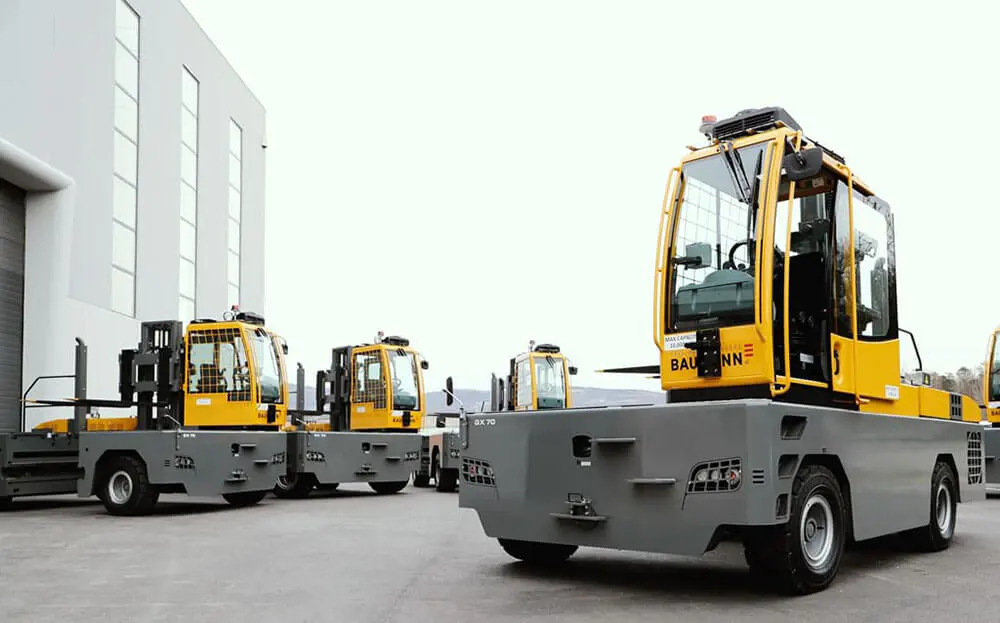
Forklifts of the side loader variety are made for handling lengthy, clumsy items that require lateral stability during transit.
Sideloaders have a mast that is mounted on the side of the vehicle. It extends outwards to lift the load. They can maneuver heavy loads in narrow aisles and tight spaces.
Here are some features of side loaders:
- The wheelbase of side loaders is broad, and their center of gravity is low. With big loads, they are more stable.
- Sideloaders can move diagonally as well as in any other direction. They can readily move through constrained areas and confined aisles.
- Sideloaders are used in a bunch of industries because of their versatility. They are relevant to most operations conducted in a warehouse.
- Sideloaders can reduce the number of moves required to transport long loads.
- In comparison to other forklift types, side loader forklifts may have cheaper operational expenses. They can carry longer loads and take up less aisle space.
Latest Technologically Advanced Warehouse Material Handling Equipment List.
There are several pieces of cutting-edge warehouse material handling equipment on the market. These tools are essential today for a number of reasons. A few of these are:
- Autonomous mobile robots
- Automated guided vehicles
- Collaborative robots
The ability to lessen the physical strain on workers is one of the main advantages of technologically advanced equipment.
Modern machinery can also increase productivity and efficiency in warehouse operations. They support supply chain optimization, cost reduction, and operational simplification.
Autonomous Mobile Robots
Autonomous mobile robots are intelligent machines. They can navigate and operate autonomously in a warehouse, manufacturing plant, or other industrial setting.
Advantages Of Autonomous Mobile Robots
The use of autonomous mobile robots or AMRs can provide businesses with a competitive advantage. Some of the advantages of autonomous mobile robots are:
- AMRs can operate around the clock without the need for breaks. They are more efficient this way as they finish tasks faster.
- AMRs are equipped with advanced sensors and cameras that allow them to detect obstacles and avoid collisions. These attachments help the robot avoid collisions and accidents.
- A fleet of equipment that already exists can easily accommodate AMRs without requiring major adjustments.
- AMRs are adaptable and can be programmed to carry out a number of activities. They are also easily reprogrammable or reconfigurable to accommodate shifting production demands.
- AMRs can reduce labor costs by performing repetitive or physically demanding tasks that would need multiple human laborers.
Automated Guided Vehicles
AGVs, or automated guided vehicles, are mobile robots that operate on their own. In a warehouse, their main functions are material handling and transportation.
Utilizing AGVs can assist companies in streamlining processes and increasing productivity.
Uses of Automated Guided Vehicles In Your Warehouse
Some of the ways in which AGVs are used in a warehouse are:
- AGVs can be used to transport goods from different areas in a warehouse. They can be used to move goods and materials to and from inventory storage areas.
- For order fulfillment, AGVs can pick up and move single objects as well as small quantities of merchandise. By using AGVs for this, errors are decreased.
- Pallets of goods are loaded and unloaded from trucks or storage racks using AGVs.
Safety Considerations In The Warehouse Material Handling Equipment.
Safety is a top priority when it comes to operating warehouse material handling equipment. Some of the safety procedures to follow in the warehouse when operating material handling equipment are:
- Training and certification
- Environmental factors
- Regulations and Standards
- Capacity and load limits
- Inspection and maintenance
Training & Certification
To handle material handling equipment, operators must have the necessary training and certification.
This includes instructions on safety precautions and how to use the equipment correctly to prevent mishaps.
Environmental Factors
When selecting material handling equipment, it is important to consider the operating environment.
The safety of the equipment might be impacted by variables like temperature, humidity, and floor coverings.
Regulations and Standards
A crucial component of the safety of material handling equipment is regulations and standards.
Companies can ensure that their material handling equipment is operated in a safe and responsible manner by following these.
Capacity And Load Limits
Tipping over, collapsing, or other accidents may result from overloading. It’s crucial to make sure that the load and capacity limits of the equipment are not exceeded.
Inspection And Maintenance
Equipment safety depends on routine inspections and maintenance. In order to identify and manage any safety issues, maintenance is necessary.
Material Handling Equipment Customization.
Material handling equipment customization involves the modification of existing equipment to meet specific operational requirements.
The customization of material handling equipment is essential to ensure maximum efficiency in a warehouse.
Equipment customization may entail changing the equipment’s size to accommodate certain space restrictions. Additionally, customization could entail adding security components like sensors, alarms, and safety obstacles.
Customized elements like automated control systems or customized attachments can also be included. This may result in better order fulfillment times, higher throughput, and lower labor costs.
Advantages Of Customizing Material Handling Equipment
Some of the advantages of customizing equipment to meet the requirements of specific applications are:
- Customization can help to improve safety by designing equipment with safety features specific to the business. This reduces risks and accidents that may halt operations.
- They have a high initial cost but these customizations pay off well in the future. The lifespan, upkeep, and frequency of replacement of customized equipment are all increased.
- Warehouses can streamline processes, reduce downtime, and improve overall productivity. This can be achieved by customizing material handling equipment to specific tasks.
- Customized equipment can give a business a competitive advantage. With increased efficiency positive customer feedback is generated.
How To Customize Material Handling Equipment?
The following phases are commonly included in the design and construction of specialized material-handling equipment:
- An evaluation of the present tools and procedures is part of the first stage. You must also pinpoint any inefficiencies or security issues.
- A conceptual design for the equipment will be created. This will be done by the equipment producer based on the analysis.
- The manufacturer will start the engineering and detailing step as soon as the conceptual design has been approved.
- The manufacturing process will then get started. This might entail breaking, welding, and assembling the different parts of the machinery.
- Following the fabrication stage, the equipment will undergo a series of tests to ensure that it meets client requirements.
- It will be sent to and installed at the client’s location.
Method Of Selecting The Right Warehouse Material Handling Equipment.
Below, we are going to explain how to choose the right material equipment for your warehouse:
Warehouse Racking Type
You should find out what kind of racking types you are using in your warehouse. Based on the warehouse racking type, you need to choose the right material handling equipment.
For instance, a narrow aisle pallet racking system needs a narrow aisle forklift. Double deep pallet racking system needs forklifts that can reach deeper into the pallet racks.
To have an idea about the relation between pallet racking types, and the use of material handling equipment, read this part of the article where the use of various types of forklifts as material handling equipment has been described in Brief.
Project Budget
Project budget is another thing to consider while choosing the right type of material handling equipment for your warehouse.
For instance, technologically advanced warehouse material handling equipment is expensive compared to traditional warehouse material handling equipment.
But at the same time, you can do the work of material handling a lot faster with technologically advanced warehouse material handling equipment.
So, you need to consider your project budget while choosing material handling equipment.
Keeping in Mind Worker’s Training and Ability to Operate The Material Handling Equipment
To operate a warehouse material handling equipment like forklifts or AGVs, the warehouse workers need to be trained. However, learning to operate technologically challenging AGVs is a lot harder compared to operating forklifts.
So before ordering a specific type of material handling equipment, you should make sure that your warehouse workers will be able to operate that.
Based On Actual Material Handling Needs
You need to know about the advantages and disadvantages of various warehouse material handling equipment. For instance, some warehouse material handling equipment can be costly, but you can do your work a lot faster with that equipment.
Some warehouse material handling equipment might be cheaper, but it will take a lot of time to move things from one place to another.
Some warehouse material handling equipment might be an excellent choice, but it might not be fit for your particular warehouse. For instance, in a warehouse where a narrow pallet racking system is used, narrow aisle forklifts can only operate as warehouse material handling equipment.
So, based on the above-mentioned points, you should choose the right material handling equipment.
The importance of selecting the right material handling equipment is very important. The basic importance of material handling is to choose appropriate materials handling equipment that is safe and fulfills the requirements.
Technological advancement has changed many things in the world. It has also made its impact on the warehouse material handling equipment.
In warehouses, where labor costs are too high, warehouse owners should go for technologically advanced warehouse material handling equipment.
Although the initial costs of technologically advanced warehouse material handling equipment are higher, this will be beneficial for the warehouse owner in the long run.
However, due to its easy-to-operation method and lower cost, the traditional warehouse material handling equipment is still dominant in most parts of the world.
So, where the labor cost is cheaper, warehouse owners can go for traditional warehouse material handling equipment such as roll containers, forklifts, wire containers, etc.
This type of traditional warehouse material handling equipment can be done with very low investment.
So, this is all you need to know about the most complete list of warehouse material handling equipment.
If you select the right material handling equipment for your warehouse, it will definitely increase the overall efficiency of your warehouse. Consider contacting Mracking to find out the best warehouse material handling equipment.




